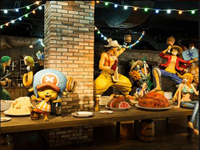Yawata Steel Works

Fantastical Treasure Trove of Beautiful Factory Nightscapes
There are very few people even in Japan who aren’t spellbound by the beautiful night views of the factories. The aesthetic architecture of the massive plant constructions, their reflections on the water’s surface, and the whole night view wrapped in lights is nothing less than romantic. There are many places all over the city from which one can get stunning views of the industrial zones of Kitakyushu. (Special night view cruises run from the Kokura Bay every 1st, 2nd, 3rd, and 5th Saturdays.)

World Cultural Heritage Site Registered as “Sites of Japan’s Meiji Industrial Revolution”
In 2015, various facilities of the Yawata Steel Works such as the former administration building, repair shop, and old forge are registered as an official World Cultural Heritage Site because of their contribution to the four industries of “Japan’s Meiji Industrial Revolution of iron, steel, shipbuilding and coal mining.” This is a valuable cultural property which reveals the fusion of industrial techniques imported from the West along with traditional Japanese culture that had progressed so rapidly over such a short time.

Preserved Section of the Factory: Higashida Blast Furnace No. 1 Historical Park
The No. 1 blast furnace of the Yawata Steel Works is a monument preserved as a historical park. The giant blast furnace is just as the name suggests, a massive 100 m tall furnace that would extract the pit iron from the iron ores which was very important to the facilities’ production. This blast furnace with such practical structural beauty is also the symbol of the steel works.
Fantastical Treasure Trove of Beautiful Factory Nightscapes
There are very few people even in Japan who aren’t spellbound by the beautiful night views of the factories. The aesthetic architecture of the massive plant constructions, their reflections on the water’s surface, and the whole night view wrapped in lights is nothing less than romantic. There are many places all over the city from which one can get stunning views of the industrial zones of Kitakyushu. (Special night view cruises run from the Kokura Bay every 1st, 2nd, 3rd, and 5th Saturdays.)

World Cultural Heritage Site Registered as “Sites of Japan’s Meiji Industrial Revolution”
In 2015, various facilities of the Yawata Steel Works such as the former administration building, repair shop, and old forge are registered as an official World Cultural Heritage Site because of their contribution to the four industries of “Japan’s Meiji Industrial Revolution of iron, steel, shipbuilding and coal mining.” This is a valuable cultural property which reveals the fusion of industrial techniques imported from the West along with traditional Japanese culture that had progressed so rapidly over such a short time.

Preserved Section of the Factory: Higashida Blast Furnace No. 1 Historical Park
The No. 1 blast furnace of the Yawata Steel Works is a monument preserved as a historical park. The giant blast furnace is just as the name suggests, a massive 100 m tall furnace that would extract the pit iron from the iron ores which was very important to the facilities’ production. This blast furnace with such practical structural beauty is also the symbol of the steel works.






